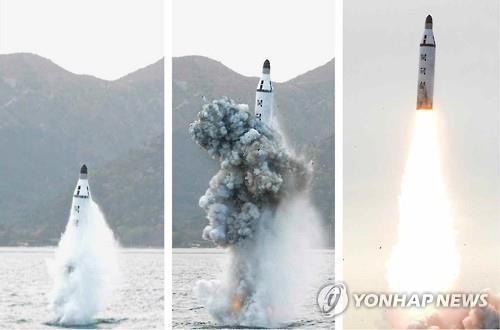US experts suspects China of providing SLBM for NK
By Yoon Min-sikPublished : Sept. 2, 2016 - 16:22
North Korea’s unexpected advancement in submarine launched ballistic missile program may have been aided by Chinese technology, a US expert on Korean studies said Thursday, raising suspicion that Beijing may have provided their own SLBM for Pyongyang.
Bruce Bechtol, a professor of security studies and criminal justice at Angelo State University, said that the recently launched KN-11 SLBM of the North is similar in function and appearance to China’s JL-1.
“The missile that the North Koreans launched looks like it’s a two-stage missile, just like the JL-1. It looks like a solid-fuel missile, just like the JL-1,” said Bechtol, the author of “North Korea and Regional Security in the Kim Jong-un Era, while appearing in the John Batchelor Show radio news program.
JL-1 is China’s first submarine-launched ballistic missile launched and deployed in the 1980s. It is believed to have a maximum range of over 1,700 kilometers.
Bruce Bechtol, a professor of security studies and criminal justice at Angelo State University, said that the recently launched KN-11 SLBM of the North is similar in function and appearance to China’s JL-1.
“The missile that the North Koreans launched looks like it’s a two-stage missile, just like the JL-1. It looks like a solid-fuel missile, just like the JL-1,” said Bechtol, the author of “North Korea and Regional Security in the Kim Jong-un Era, while appearing in the John Batchelor Show radio news program.
JL-1 is China’s first submarine-launched ballistic missile launched and deployed in the 1980s. It is believed to have a maximum range of over 1,700 kilometers.

“It looks like we may have a smoking gun based on the most recent submarine launched ballistic missile test that we saw the North Koreans do on Aug. 24.”
North Korea last week celebrated its first successful launch of the KN-11, a feat that bamboozled military experts here who had expected at least 3-4 years until deployment of the weapon.
Bechtol pointed out that the missile, unlike most of Pyongyang’s arsenal, had successfully flown for 310 miles (500 kilometers), raising questions over Pyongyang’s sudden stride in the SLBM program.
While the communist state has conducted multiple SLBM tests prior to the Aug. 24 launch, they were all assessed to have failed in the initial phases. But the most recent test was evaluated to have entered the flight stage.
The launch sent alarms across South Korea, with ruling party hawks renewing calls to develop nuclear-powered submarine in the battlefield. Seoul is currently restricted from non-civilian use of nuclear technology by its agreement with Washington and has a lack of uranium-enrichment facility.
Bechtol said that he and Tal Inbar of Israel’s Fisher Institute -- for air and space strategic studies -- agree that the North Korean missile looks like “a carbon copy of the JL-1.” If it is not a carbon copy, it looks to be a variant at least, he said.
The professor stated that the JL-1 was first tested in a Golf-class submarine. This is significant in that the North’s KN-11 was launched in a Sinpo-class submarine, which is assessed to be a variant of an old Golf-cass submarine Pyongyang acquired from Russia in the early 1990s.
China has been accused of providing the hermit kingdom of military equipment.
In 2012, Japanese media reported that China has exported transporter erector launchers to North Koreans, although Beijing’s foreign ministry denied such claims.
US state refused to comment on Bachtol’s assessments.
Regardless of how or if North Koreans have gotten a hold of the Chinese missiles, the North’s use of Chinese missiles is likely to drastically change the development timeline for the North’s SLBMs.
John Schilling of 38 North, a North Korea-monitoring website, said that the North’s SLBM may be deployed in an initial operational capacity as early as second half of 2018.
Some have raised a possibility that the North may claim to have the capacity to fire SLBM even before sufficient testing.
Pyongyang has deployed its intermediate-range Musudan missiles since 2007, although its first test launch was conducted this year.
Military officials say even if the North’s claims on its strike capacities are not verified, the deployment itself forces them to prepare countermeasures against such strategic assets like the Musudan or the KN-11.
With the inter-Korea tensions at its highest in recent years, South Korea and the US on Friday wrapped up their annual Ulchi Freedom Guardian exercise.
This year’s exercise, which kicked off on Aug. 22, had reportedly included the operation plan 5015 that stipulates pre-emptive precision strikes against the Kim Jong-un regime and its nuclear and missile facilities.
By Yoon Min-sik
(minsikyoon@heraldcorp.com)


![[Exclusive] Korean military set to ban iPhones over 'security' concerns](http://res.heraldm.com/phpwas/restmb_idxmake.php?idx=644&simg=/content/image/2024/04/23/20240423050599_0.jpg&u=20240423183955)




![[Herald Interview] 'Amid aging population, Korea to invite more young professionals from overseas'](http://res.heraldm.com/phpwas/restmb_idxmake.php?idx=644&simg=/content/image/2024/04/24/20240424050844_0.jpg&u=20240424200058)

![[Pressure points] Leggings in public: Fashion statement or social faux pas?](http://res.heraldm.com/phpwas/restmb_idxmake.php?idx=644&simg=/content/image/2024/04/23/20240423050669_0.jpg&u=)









